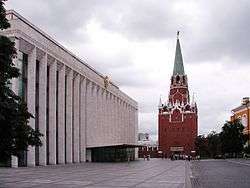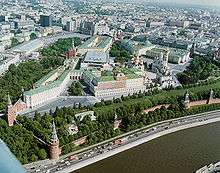State Kremlin Palace
| Государственный Кремлёвский Дворец | |
| Kremlin Palace of Congresses (1961-92) | |
 | |
| Address |
ul. Vosdvizhenka d.1 Moscow 121019 Russia |
|---|---|
| Designation | UNESCO World Heritage Site |
| Capacity | 6,000 |
| Production |
Zarkana Kremlin Ballet |
| Construction | |
| Opened | 17 October 1961 |
| Architect | Michael Posohin, Ashot Mndoyants and Eugene Stamo |
| Website | |
| Venue Website | |

The State Kremlin Palace (Russian: Государственный Кремлёвский Дворец), formerly and unofficially still better known as the Kremlin Palace of Congresses (Кремлёвский Дворец съездов), is a large modern building inside the Moscow Kremlin.
Background
The building was built at the initiative of Nikita Khrushchev as a modern arena for Communist Party meetings. Although the architecture of the projected building contrasted sharply with the historic milieu, building work started in 1959. The structure was opened along with the 22nd Congress of the Communist Party of the Soviet Union on October 17, 1961. In 1962 the architects of the project, headed by Mikhail Posokhin were awarded the Lenin Prize for their work.
The building is a modern glass and concrete design, with nearly half of it (17 metres) submerged underground. The main hall is able to hold six thousand people and its acoustics were considered to be the most advanced at the time. Over the years this was the main place for mass state events (particularly party congresses). Presently it is used for official and popular concerts. American singers Mariah Carey, Tina Turner and Cher have played in the palace, as did Canadian poet and singer-songwriter Leonard Cohen. Additionally, it is the venue of the Kremlin ballet group. Also the Bolshoi Theatre was performing there while its historic building was closed for repairs. The number of individual rooms is well over eight hundred.
Externally the palace is faced with white marble and the windows are tinted and reflective, which makes the ancient architecture in the Kremlin appear particularly picturesque. However, from the start, the construction of a large modern public building in an historic neighborhood generated quite an uproar, especially since the building replaced several heritage buildings including the old neo-classical building of the State Armory and some of the back corpuses of the Great Kremlin Palace. Although this was hardly the first time that the Soviet government destroyed architectural heritage (notably the Chudov and Ascension cloisters) in the Kremlin and in the country in general, by the mid 1950s laws were in place effectively considering all pre-Soviet constructions as historical monuments and preventing their demolition, in someways making the construction illegal. Nevertheless, the Palace was integrated into the larger complex of the Great Kremlin Palace with walkways linking it to the Patriarchal chambers and the Terem Palace.
Party congresses in the Kremlin Palace
Communist Party of the Soviet Union (1961–1991)
 XVII Congress the Trade unions in the Soviet Union,
XVII Congress the Trade unions in the Soviet Union,
19 March 1982. 20 Congress the Komsomol,
20 Congress the Komsomol,
1 February 1987.
Party A Just Russia (2008)
See also
External links
- http://www.gkd-kremlin.ru/ Official site
- (Russian)/(English) Description on the Official page of the Kremlin museum
- (Russian)/(English) Description on the Official page of the Presidency
- (English) Satellite shot centred on the building
Coordinates: 55°45′5″N 37°36′56″E / 55.75139°N 37.61556°E
